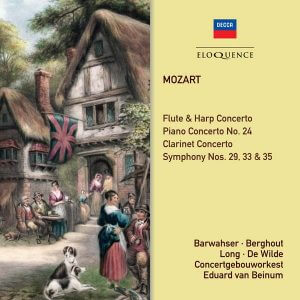various concerto soloists
Symphonies 29, 33 & 35
Concertgebouworkest
Eduard van Beinum, conductor
Eloquence 482 5525 (2CD)
TPT: 147’ 11”
reviewed by Neville Cohn
 Not the least of the many good things flowing from this re-issue of Philips LP recordings in the compact disc format is making available to an entirely new constituency of listeners the work of musicians of considerable consequence whose recordings of decades ago, for a variety of reasons, have, as it were, fallen through the cracks. The tireless Cyrus Meher-Homji continues this important work with a 2CD re-issue of an all-Mozart compilation of recordings that thoroughly deserve being brought back to life.
Not the least of the many good things flowing from this re-issue of Philips LP recordings in the compact disc format is making available to an entirely new constituency of listeners the work of musicians of considerable consequence whose recordings of decades ago, for a variety of reasons, have, as it were, fallen through the cracks. The tireless Cyrus Meher-Homji continues this important work with a 2CD re-issue of an all-Mozart compilation of recordings that thoroughly deserve being brought back to life.
As a young teenager, I was given an LP recording of Hubert Barwahser playing on the now defunct Philips label. I still have it. Here, Barwahser sounds at his eloquent, articulate best in ensemble with another almost-forgotten soloist: Phia Berghout on harp in the Concerto for flute and harp. Yet another musician richly deserving this resurrection is the formidably gifted English pianist Kathleen Long who in the mid-20th century enjoyed a dazzling career.
This is vintage Long. Listen to her playing Mozart’s C minor concerto; it’s a joy from start to finish, blissfully free of fuss or frills.
Presiding over events from the podium is Eduard van Beinum, a first rate musician to which the players of the Concertgebouw Orchestra would respond time and again to provide some of the most satisfying and meaningful recorded music in mid-century Europe and further abroad.
Bram de Wilde is a fine soloist in the Clarinet Concerto. Tone quality is particularly appealing in the chalumeau register. The work unfolds near-flawlessly.
Van Beinum recorded Symphony No 29 in 1957. Sixty years on, it’s as relevant and stylistically meaningful as it would have been when first made available on LP.
This CD is all the more to be treasured because these works are the ONLY Mozart works which van Beinum recorded with the Concertgebouworkest.


